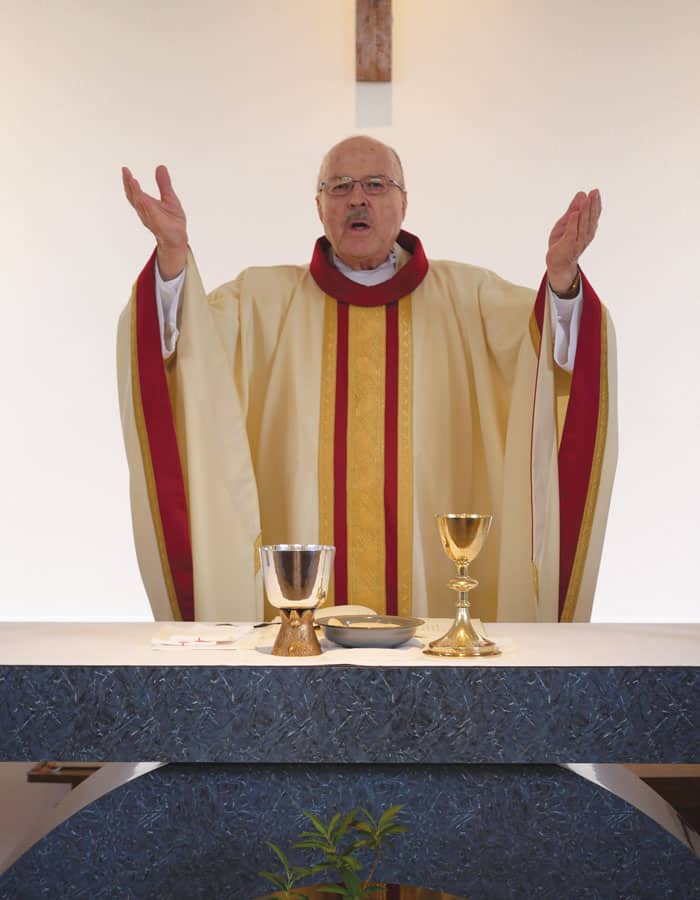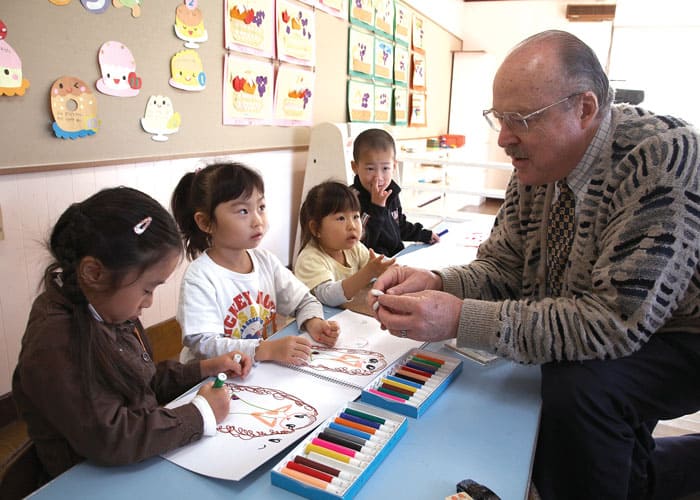In Japan’s port city of Muroran, Father Frank Riha is considered one of their own.
The train pulls into Higashi-Muroran Station on Japan’s northern island of Hokkaido just before 9 a.m. Maryknoll Father Frank Riha is waiting outside in his full-size Toyota Crown hybrid to pick up his visitors.
The missioner serves in Muroran, a port city of 80,000. At 79, he looks strong and healthy, and he’s happy to be here. He has served on Hokkaido for 43 years, and the first dozen were spent in Muroran. He only recently returned to this city, where he was first assigned to the parish of Higashi (East) Muroran.
“It was my first parish as a pastor,” Father Riha says. “Coming back after 30 years in a neighboring city was somewhat emotional for me. But the reception I received was beyond my imagination.”
Born in Boston and ordained in 1968, Father Riha has spent all his overseas missionary years in Japan. For about seven years he served in other parts of the country before coming north to Hokkaido.
Father Riha is not only pastor of Higashi (East) Muroran but also of the Noboribetsu parish as well. He is also the director and principal of the large kindergarten attached to the Noboribetsu Catholic church.

At an unadorned altar in Higashi (East) Muroran parish Father Frank Riha celebrates Sunday liturgy with a “different aliveness” than in Africa and Latin America. (Peter Saunders/Japan)
“When I first came to Muroran all those years ago, I used to celebrate Mass with the Benedictine Sisters at their nearby convent,” he says. “I got involved with the kindergarten which the sisters were running. I would go once a week to teach the children English, or rather play with the children in English. When I went to [the neighboring city of] Tomakomai, I already had 10 years of experience working with kids and also teaching the teachers, not just English but talking about Christianity.”
This proved useful when the bishop asked him to be the principal of the Tomakomai Holy Mother Kindergarten, which had between 40 and 60 children at different times. Returning to Muroran, he finds himself director of the Noboribetsu Sacred Heart Kindergarten, with an enrollment of 140 children ages 3-6, and 20 teachers.
Today Father Riha drives his visitors to Higashi (East) Muroran Catholic Church compound. At some churches in Japan you keep your shoes on, but at this one you take them off and wear provided slippers. The highly polished wooden floors match the clean white interior of the church, recently rebuilt.
It’s Father’s Day, before the arrival of COVID-19. In the kitchen of the community room right behind the church, women are busy preparing a special feast.
Mass starts at 9:30 and the church is almost full. Most of the congregation is elderly, many of the women wearing lace veils. The missioner begins the liturgy with an altar server and two lectors at the unadorned, candle-lit altar, a beautiful carved wooden crucifix overhead.
Father Riha describes the typical Japanese Mass as unlike liturgies in Africa or Latin America with their drums or guitars. “It is a different aliveness here,” he says. “Singing psalms and Gregorian chant-style is popular.” Accompanied by an organ, the singing is solemn. Sake decanters hold the water and wine to be consecrated, and the rite of peace consists of bowing to each other, though some members of the congregation shake hands after bowing. At Communion time, Father Riha distributes the sacred host in the middle aisle while two eucharistic ministers stand on the side aisles offering the chalice with the precious blood.
At a typical Sunday liturgy in Higashi (East) Muroran parish, most of the congregation is elderly and women wear lace veils as they solemnly worship in Japanese style.
Parishioner Ken-ichi Matsuoka, 79, provides context on the local Catholic community. He was baptized in an earlier version of the same church 51 years ago. There are around 300 Catholics in the parish, he says, although fewer than 200 attend church. “Japan’s aging population and [negative] growth rate are taking a toll,” he says. “Different eras have different ways of thinking. The youth are in a bind today. Their work is difficult and we have a constant shortage of youth. We must reflect on: What are the young people looking for? What is it that motivates them, that helps them look toward the future with hope? Isn’t this the hope and love we can find in Jesus? How do we get this across to the younger generations?”
Father Riha says that the major changes of Vatican II took place around the time he arrived in Japan in 1968, and Maryknoll missioners helped the congregation here to transition by providing study groups. As was the case around the world, the shift away from Latin Mass meant greater variations among congregations within Japan. While in Muroran the Mass is traditionally Japanese and solemn, in churches in other regions of the country with large migrant worker populations—coming from countries like Peru, Brazil, Kenya and the Philippines—the Mass is likely to include drums, guitars and big hugs.
Mass ends with a blessing for all the men who are fathers. Then it’s time for the Mongolian barbecue feast in the community room. The whole congregation, sitting at half a dozen tables, enjoys the grilled meat, rice wrapped in seaweed, vegetables and green tea. Father Riha gets up and mingles with members of his community afterwards. On this Father’s Day it is clear he is a father figure to his community, which shows great love and respect for him. He says he has no intention of retiring any time soon and hopes to stay here as long as possible.
Recalling the warm greetings he received here after 30 years away, he expresses great joy in the way parishioners treat him as one of their own. “There were … quite a few who said, ‘Welcome home, Father!’ I don’t think there is anything better one can say about the people and the city called Muroran.”
Featured image: At a barbecue after Mass, a smiling Father Riha mingles with members of his Higashi (East) Muroran parish. (Peter Saunders/Japan)

In his previous assignment in the city of Tomakomai, Father Frank Riha enjoyed interacting with the children in Holy Mother Kindergarten, where he served as principal. (Sean Sprague/Japan)
![]()

